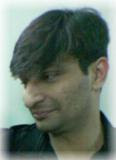Input Devices: The user connection
Most of the data comes in hand written forms that cannot be directly input into the computer. These documents need special data preparation devices that translate the source document into a medium that the computer can read, such as a magnetic disk. Input devices are used to input or capture data into a computer system. The ideal input device would be able to get data into a system as accurately as possible in the least amount of time.
There are wide ranges of input devices used today:
Keyboard
The keyboard of all input devices is the oldest and most familiar. Keyboards are devices that contain their own chips. Basically each key in the keyboard acts as a switch, which is switched on when the key is pressed.
The microprocessor scans the keyboard hundreds of times a second to see if a key has been pressed; if it has, a code that denotes which key has been pressed is sent to the processing unit. The CPU translates this code into an ASCII code (the code that computers use to represent characters on the computer keyboard), which is then used by a computer program.
Mouse
A mouse is an input device that usually has one, two or three buttons, which are used to make selections on the screen. It is a pointing device. A mouse translates its movements on the desktop into digital information; this is fed to the computer, which in turn causes the cursor to move on the screen. The cursor is the blinking line on the screen, which indicates that the computer is ready to type. Underneath the mouse is a rotating ball and as the mouse is moved on the desk, and sensors pick up this movement to move the pointer on the screen. (The pointer helps the user point and click on an icon or menu on the screen).
Trackball
What do you get when you turn a computer mouse upside down? A trackball! The ‘mouse' stays still while the user rotates the ball. Trackballs are often seen on laptop computers because it has the advantage of taking up much less space compared with a conventional mouse. It is a pointing device.
Joystick
A joystick is similar to a trackball. Whenever the stick is moved, the pointer moves in a similar direction on the screen. Joysticks are commonly used for games, but you can also see them being used for scanning purposes in hospitals.
Scanner
Scanners are used to scan text or pictures into a computer's memory. Then the scanned image is manipulated in some way before being printed. There are cheap hand held scanners and or flatbed A4 sized ones. Both black and white and color scanners are available.
Touch Screen
A touch screen is a special kind of screen. This is sensitive to touch. A selection is made from usually a menu present on the screen, which is activated by touching part of it. These screens are ideal for use in banks, restaurants and bars, where customers who are not use to keyboards can obtain information about the services offered.
Light Pen
A light pen is a pen-shaped device held in the hand. The presence or absence of light is detected by it. The pen is used to select a particular point on the screen. The screen is refreshed about every 1/50th of a second by a point of light travelling rapidly across it. The pen detects this point of light and the computer can work out by precise timing where the pen is. Light pens need special software to make them work and are mainly used for design work using CAD packages.
Digital Camera
Digital cameras allow the user to transfer the photographs taken, directly into the computer. Previously, if a photograph had to be input into the computer, it had to first scan using a computer scanner and then viewed on the screen. Digital cameras eliminate the requirement for a scanner. No film or photographic paper is needed. The quality of photographs obtained even from low cost digital cameras is quite good. Digital cameras are very efficient to use especially if you want to take photos and edit them later on the computer.
Sensors
For industrial computer applications, such as process control, the computer is required to interact directly with the plant. Since the computer can only communicate with the outside world by using electrical signals, any devices connected to it must be made compatible using analog to digital converters (ADC) and digital to analog converters (DAC).
Sensors are designed to pick up analogue values of the physical variables and feed them into the computer.
Example:
• temperature
• pressure
• intensity of light
• electrical voltages
• electrical currents
• switch positions
Depending on the values received by the computer, it activates other output devices like motors, valves etc.
Tuesday, June 9, 2009
Subscribe to:
Post Comments (Atom)

No comments:
Post a Comment